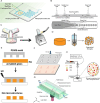The use of hydrogel microspheres as cell and drug delivery carriers for bone, cartilage, and soft tissue regeneration
- PMID: 39734701
- PMCID: PMC11681182
- DOI: 10.12336/biomatertransl.2024.03.003
The use of hydrogel microspheres as cell and drug delivery carriers for bone, cartilage, and soft tissue regeneration
Abstract
Bone, cartilage, and soft tissue regeneration is a complex process involving many cellular activities across various cell types. Autografts remain the "gold standard" for the regeneration of these tissues. However, the use of autografts is associated with many disadvantages, including donor scarcity, the requirement of multiple surgeries, and the risk of infection. The development of tissue engineering techniques opens new avenues for enhanced tissue regeneration. Nowadays, the expectations of tissue engineering scaffolds have gone beyond merely providing physical support for cell attachment. Ideal scaffolds should also provide biological cues to actively boost tissue regeneration. As a new type of injectable biomaterial, hydrogel microspheres have been increasingly recognised as promising therapeutic carriers for the local delivery of cells and drugs to enhance tissue regeneration. Compared to traditional tissue engineering scaffolds and bulk hydrogel, hydrogel microspheres possess distinct advantages, including less invasive delivery, larger surface area, higher transparency for visualisation, and greater flexibility for functionalisation. Herein, we review the materials characteristics of hydrogel microspheres and compare their fabrication approaches, including microfluidics, batch emulsion, electrohydrodynamic spraying, lithography, and mechanical fragmentation. Additionally, based on the different requirements for bone, cartilage, nerve, skin, and muscle tissue regeneration, we summarize the applications of hydrogel microspheres as cell and drug delivery carriers for the regeneration of these tissues. Overall, hydrogel microspheres are regarded as effective therapeutic delivery carriers to enhance tissue regeneration in regenerative medicine. However, significant effort is required before hydrogel microspheres become widely accepted as commercial products for clinical use.
Keywords: drug delivery; fabrication techniques; hydrogel microspheres; microgels; tissue regeneration.
Figures








Similar articles
-
Management of urinary stones by experts in stone disease (ESD 2025).Arch Ital Urol Androl. 2025 Jun 30;97(2):14085. doi: 10.4081/aiua.2025.14085. Epub 2025 Jun 30. Arch Ital Urol Androl. 2025. PMID: 40583613 Review.
-
The Black Book of Psychotropic Dosing and Monitoring.Psychopharmacol Bull. 2024 Jul 8;54(3):8-59. Psychopharmacol Bull. 2024. PMID: 38993656 Free PMC article. Review.
-
Guided tissue regeneration for periodontal infra-bony defects.Cochrane Database Syst Rev. 2006 Apr 19;(2):CD001724. doi: 10.1002/14651858.CD001724.pub2. Cochrane Database Syst Rev. 2006. Update in: Cochrane Database Syst Rev. 2019 May 29;5:CD001724. doi: 10.1002/14651858.CD001724.pub3. PMID: 16625546 Updated.
-
Physical activity and exercise for chronic pain in adults: an overview of Cochrane Reviews.Cochrane Database Syst Rev. 2017 Jan 14;1(1):CD011279. doi: 10.1002/14651858.CD011279.pub2. Cochrane Database Syst Rev. 2017. Update in: Cochrane Database Syst Rev. 2017 Apr 24;4:CD011279. doi: 10.1002/14651858.CD011279.pub3. PMID: 28087891 Free PMC article. Updated.
-
Extracellular vesicles derived from Schwann cells to enhance bone and dental tissue regeneration: a literature review.J Nanobiotechnology. 2025 Jul 11;23(1):502. doi: 10.1186/s12951-025-03585-7. J Nanobiotechnology. 2025. PMID: 40646600 Free PMC article. Review.
Cited by
-
Engineering NO delivery system renormalizes the excitability of inhibitory interneurons after spinal cord injury via chloride extrusion.Bioact Mater. 2025 Jul 17;53:300-313. doi: 10.1016/j.bioactmat.2025.07.022. eCollection 2025 Nov. Bioact Mater. 2025. PMID: 40703336 Free PMC article.
-
Lactoferrin Stimulates Chondrogenesis and Promotes Healing of the Auricular Elastic Cartilage.Int J Mol Sci. 2025 Feb 24;26(5):1956. doi: 10.3390/ijms26051956. Int J Mol Sci. 2025. PMID: 40076584 Free PMC article.
-
Plant-Derived Bone Substitute Presents Effective Osteointegration in Several Clinical Settings: A Pilot Study from a Single Center.Bioengineering (Basel). 2025 Aug 11;12(8):861. doi: 10.3390/bioengineering12080861. Bioengineering (Basel). 2025. PMID: 40868374 Free PMC article.
-
3D-printed advanced scaffold armed with exosomes derived from human skeletal stem cell identified by single-cell RNA sequencing enhances osteochondral regeneration.Bioact Mater. 2025 May 14;51:231-256. doi: 10.1016/j.bioactmat.2025.04.028. eCollection 2025 Sep. Bioact Mater. 2025. PMID: 40487240 Free PMC article.
-
Intelligent Manufacturing for Osteoarthritis Organoids.Cell Prolif. 2025 Jul;58(7):e70043. doi: 10.1111/cpr.70043. Epub 2025 Apr 26. Cell Prolif. 2025. PMID: 40285592 Free PMC article. Review.
References
-
- Xiong Y., Mi B. B., Lin Z., Hu Y. Q., Yu L., Zha K. K., Panayi A. C., Yu T., Chen L., Liu Z. P., Patel A., Feng Q., Zhou S. H., Liu G. H. The role of the immune microenvironment in bone, cartilage, and soft tissue regeneration: from mechanism to therapeutic opportunity. Mil Med Res. 2022;9:65. - PMC - PubMed
Publication types
Grants and funding
LinkOut - more resources
Full Text Sources
Research Materials
